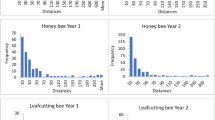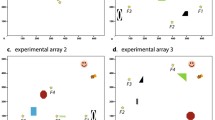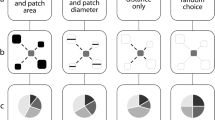Summary
The stochastic, discrete analogue of the marginal value theorem predicts that as the cost of moving between plants increases, bees should increase the percentage of the available flowers which they visit per plant. This prediction was tested using two populations of Polemonium foliosissimum and their primary pollinators Bombus flavifrons and B. bifarius. The results of these tests were equivocal. Bees did not perform exactly as the marginal value theorem predicted they should to maximize their rate of net energy intake. Instead of visiting more flowers per plant as movement costs increased bees were observed to alter their behavior in other ways in an attempt to maximize their rate of net energy intake. They were demonstrated to be flying randomly with respect to direction, flying short flight distances relative to the plant spacing distances encountered, flying predominately between nearest neighbor plants, and to be visiting flowers of other plant species while enroute from one P. foliosissimum flower to another P. foliosissimum flower. Such behavioral flexibility strongly implies that optimal foraging models which predict a shift in any particular behavior in response to environmental conditions are too simplistic to accurately predict foraging behavior.
Similar content being viewed by others
References
Anway JC (1968) The systematic botany and taxonomy of Polemonium foliosissimum A. Gray (Polemoniaceae). Am Midl Natur 79:458–475
Charnov EL (1976) Optimal foraging: The marginal value theorem. Theor Pop Biol 9:129–136
Charnov EL, Orians GH, Hyatt K (1976) Ecological implications of resource depression. Amer Natur 110:247–259
Covich A (1976) Analyzing shapes of foraging areas: Some ecological and economic theories. Annu Rev Ecol Syst 7:235–258
Cowie RJ (1977) Optimal foraging in great tits (Parus major). Nature 268:137–139
Gibb JA (1958) Predation by tits and squirrels on the eucosmid, Ernarmonia conicolana (Heyl). J Anim Ecol 27:376–396
Gibb JA (1962) L. Tinbergen's hypothesis of the role of specific search images. Ibis 104:106–111
Grant V (1950) The flower constancy of bees. Bot Rev 16:379–398
Heinrich B (1976) The foraging specializations of individual bumblebees. Ecol Monog 46:105–128
Heinrich B (1979a) “Majoring” and “Minoring” by foraging bumblebees, Bombus vagans: An experimental analysis. Ecology 60:245–255
Heinrich B (1979b) Resource heterogeneity and patterns of movement in foraging bumblebees. Oecologia (Berl) 140:235–245
Krebs JR, Ryan JC, Charnov EL (1974) Hunting by expectation or optimal foraging? A study of patch use by chickadees. Anim Behav 22:953–964
Levin DA, Anderson WW (1970) Competition for pollinators between simultaneously flowering species. Amer Natur 104:455–467
Levin DA, Kerster NW (1969) The dependence of bee-mediated pollen and gene dispersal upon plant density. Evolution 23:560–571
Levin DA, Kerster NW, Niedzlek M (1971) Pollinator flight directionality and its effect on pollen flow. Evolution 25:113–118
Ollason JG (1980) Learning to forage-optimally? Theor Pop Biol 18:44–56
Pleasants JM (In Press) Competition for bumblebee pollinators in Rocky Mountain plant communities. Ecology
Pleasants JM, Zimmerman M (1979) Patchiness in the dispersion of nectar resources: Evidence for hot and cold spots. Oecologia (Berl) 41:283–288
Pyke GH (1978a) Optimal foraging in hummingbirds: Testing the marginal value theorem. Amer Zool 18:739–752
Pyke GH (1978b) Optimal foraging: Movement patterns of bumblebees between inflorescences. Theor Pop Biol 13:72–98
Pyke GH, Pulliam HR, Charnov EL (1977) Optimal foraging: A selective review of theory and tests. Quart Rev Biol 52:137–154
Reichman OJ, Oberstein D (1977) Selection of seed distribution types by Dipodomys merriami and Perognathus amplus. Ecology 58:636–643
Schaal BA (1978) Density dependent foraging on Liatris pycnostachya. Ecolution 32:452–454
Schoener TW (1971) Theory of feeding strategies. Annu Rev Ecol Syst 2:369–404
Waddington KD (1980) Flight patterns of foraging bees relative to density of artificial flowers and distribution of nectar. Oecologia (Berl) 44:199–204
Waser NM (1978a) Competition for hummingbird pollination and sequential flowering in two Colorado wildflowers. Ecology 59:934–944
Waser NM (1978b) Interspecific pollen transfer and competition between cooccurring plant species. Oecologia (Berl) 36:223–236
Wiens JA (1976) Population responses to patchy environments. Annu Rev Ecol Syst 7:81–120
Zimmerman M (1979a) An analysis of the reproductive strategies of Polemonium in Colorado. PhD Thesis, Washington University, St Louis
Zimmerman M (1979b) Optimal foraging: A case for random movement. Oecologia (Berl) 43:261–267
Zimmerman M (1980) Reproduction in Polemonium: Competition for pollinators. Ecology 61:497–501
Author information
Authors and Affiliations
Rights and permissions
About this article
Cite this article
Zimmerman, M. Optimal foraging, plant density and the marginal value theorem. Oecologia 49, 148–153 (1981). https://doi.org/10.1007/BF00349181
Received:
Issue Date:
DOI: https://doi.org/10.1007/BF00349181




